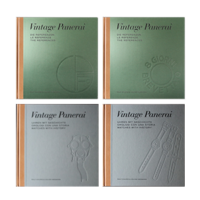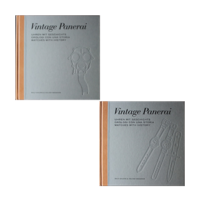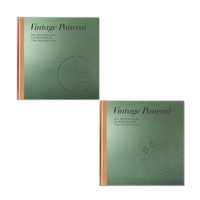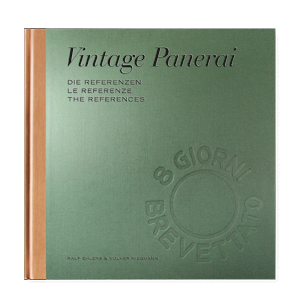Follow us on facebook… thanks for more than 2000 likes!
by autor on Nov.14, 2016, under Allgemein
 Keep in touch with the latest news and activities on Vintage Panerai. Follow us:
Keep in touch with the latest news and activities on Vintage Panerai. Follow us:
https://www.facebook.com/VintagePanerai
[Ralf Ehlers & Volker Wiegmann]
November in Geneva: five watches in two auctions
by Volker on Nov.01, 2016, under Allgemein
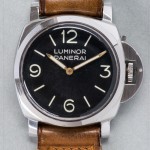 Geneva based auctioneers Phillips and Christie’s will offer five Vintage Panerai watches in their upcoming auctions between 12 and 14 November 2016.
Geneva based auctioneers Phillips and Christie’s will offer five Vintage Panerai watches in their upcoming auctions between 12 and 14 November 2016.
First of the five is lot 82 – a Ref. 6152/1 “Luminor Panerai” with Rolex movement and crown-protecting device in The Geneva Watch Auction: FOUR (session one: 12 November 2016, 6 pm, lots 1-100). Read more about this Ref. 6152/1 in our Watch Point. Lot 152 – a “warbird” in shape of a Ref. 3646 / Type D is the second Vintage Panerai to be auctioned at Phillips (session two: 13 November 2016, 6 pm, lots 101-196). Read more about this “Kampfschwimmer” in our Watch Point. The following lot 153, a Ref. 6154 “Small Egiziano” is the third and last Vintage Panerai watch to be auctioned at Phillips. Read more about this watch in our Watch Point.
[Photo with kindly permission / courtesy of www.phillips.com]
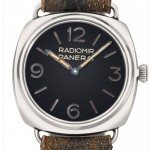 One day later, 14 November 2016, Christie’s is featuring two Vintage Panerai watches in their Sale 1417. The morning session starts at 10 am (lots 1-146) in which a Ref. 3646 / Type B with “Radiomir Panerai” dial and “Xa FLOTMAS” engraving on its caseback will be auctioned (lot 99).
One day later, 14 November 2016, Christie’s is featuring two Vintage Panerai watches in their Sale 1417. The morning session starts at 10 am (lots 1-146) in which a Ref. 3646 / Type B with “Radiomir Panerai” dial and “Xa FLOTMAS” engraving on its caseback will be auctioned (lot 99).
The afternoon session starts at 2 pm (lots 147-236), in which a Ref. 3646 / Type C with “Radiomir Panerai” dial will be up for auction (lot 209). Read more about these two Ref. 3646 watches in our Watch Point.
[Photo with kindly permission / courtesy of www.christies.com]
Watches of the Ref. 3646 / Type B, Type C and Type D are featured in our book “The References” (first volume / 1930’s-1940’s) in chapter II.II-IV.
Chapter VII and VIII.II of “The References” (second volume / 1950’s-1960’s are featuring watches of the Ref. 6154 and Ref. 6152/1. Visit our bookstore for more info.
One reference, seven variations: The 3646 / Type A-G
by Volker on Oct.12, 2016, under Allgemein
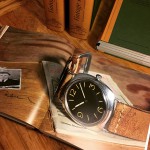 More than two hundred watches of the reference 3646 are registered in our database today. Among all different Vintage Panerai models, the 3646 marks the reference with the most known specimen in our records. In 2009, seven years ago, 143 recorded watches were featured in the first (sold out) edition of our book “The References”. Within the entire serial number sequence of the reference 3646, we differentiate between seven different variations (3646 / Type A-G).
More than two hundred watches of the reference 3646 are registered in our database today. Among all different Vintage Panerai models, the 3646 marks the reference with the most known specimen in our records. In 2009, seven years ago, 143 recorded watches were featured in the first (sold out) edition of our book “The References”. Within the entire serial number sequence of the reference 3646, we differentiate between seven different variations (3646 / Type A-G).
In our new book “The References” 1930’s-1940’s the watches of the entire reference 3646 are featured in chapter II with more than six hundred pages in the chapters II.I-II.VII following an intro on page 40-49. The seven different variations can be found in our reference quickfinder on page 14-20. The coffee table shot on the left shows one of seven specimen of the Ref. 3646 / Type C, introduced on page 322-349. Read also the extensively documented story of Helmut Rösel, first owner of this watch, in chapter IX of our book “History2”. Each of the seven variations of the reference 3646 are published here:
Chapter II.I = Reference 3646 / Type A
(featuring two different watches on page 50-169).
Chapter II.II = Reference 3646 / Type B
(featuring four different watches on page 170-247).
Chapter II.III = Reference 3646 / Type C
(featuring seven different watches on page 248-397).
Chapter II.IV = Reference 3646 / Type D
(featuring nine different watches on page 398-531).
Chapter II.V = Reference 3646 / Type E
(featuring four different watches on page 532-573).
Chapter II.VI = Reference 3646 / Type F
(featuring two different watches on page 574-607).
Chapter II.VII = Reference 3646 / Type G
(featuring two different watches on page 608-645).
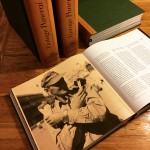 Aside numerous photos and technical illustrations of these 30 different watches, we have also published several yet unreleased historic photos of frogmen wearing watches of the reference 3646 during the Second World War.
Aside numerous photos and technical illustrations of these 30 different watches, we have also published several yet unreleased historic photos of frogmen wearing watches of the reference 3646 during the Second World War.
One of these rare photos shows “Kampfschwimmer” Werner Bullin on page 275 in chapter II.III, wearing his 3646 with “Radiomir Panerai” dial. The coffee table shot on the left shows this photo which was taken at Piazza San Marco / Venice in summer 1944. Another rare photo has been introduced earlier here. Read the extensively documented story of Werner Bullin and Heinz Günter Lehmann over the 75 pages of chapter I in our book “History1”.
The new “The References” books can be ordered only in our bookstore. Enjoy reading!
Three columns of the Panerai DNA in auction at Phillips
by Volker on Sep.25, 2016, under Allgemein
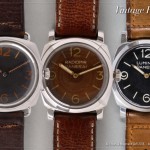 November will bring remarkable Vintage Panerai watches to auction. Phillips announced to have three columns of the Panerai DNA in their Geneva Watch Auction: FOUR.
November will bring remarkable Vintage Panerai watches to auction. Phillips announced to have three columns of the Panerai DNA in their Geneva Watch Auction: FOUR.
A German “Kampfschwimmer” Ref. 3646 / Type D, used in the Second World War, has been introduced in our Watch Point here. This warbird with anonymous sandwich dial is one of the very few watches with original strap and pin buckle – unpolished and with quite some patina.
The “Maserati” amongst Vintage Panerai references because of its flat, elegant and streamlined case is introduced in our Watch Point here. This rare Ref. 6154 “Small Egiziano” with brown “Radiomir Panerai” dial is up for auction being a “collectors’ set”, including a Guido Panerai & Figlio depth gauge, underwater torch and replacement strap with “GPF – Mod. Dep.” pin buckle.
The third column of the Panerai DNA in the Phillips Geneva Watch Auction: FOUR is a Ref. 6152/1 “Luminor Panerai” with Rolex movement and the legendary crown-protecting device from Panerai – an icon of the brand. Read more about this watch in our Watch Point here.
[Photos with kindly permission / courtesy of www.phillips.com]
One more 3646 / Type D with brass dial surfaced in the UK
by Volker on Sep.18, 2016, under Allgemein
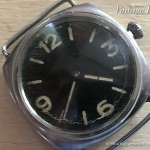 Introducing another piece of the puzzle – and one more surfaced in the United Kingdom: a Ref. 3646 / Type D with black painted brass dial and rare “Kampfschwimmer” engraving with initials of the first owner on its outer caseback. After more than 70 years the watch changed ownership once again and recently found a good new home at a Panerai collector from Germany, who provided the photo shown on the left.
Introducing another piece of the puzzle – and one more surfaced in the United Kingdom: a Ref. 3646 / Type D with black painted brass dial and rare “Kampfschwimmer” engraving with initials of the first owner on its outer caseback. After more than 70 years the watch changed ownership once again and recently found a good new home at a Panerai collector from Germany, who provided the photo shown on the left.
The watch has been added into our database in March 2016 and comes with flat bezel (a typical feature of the watches with flat dials), onion shaped “Brevet +” crown (Type 11) and Rolex Cal. 618 / Type 1 movement. The watch has never been polished and has still its original plexi, showing the typical traces of aging. The inner caseback is signed with the Rolex SA hallmark, reference and case number. A similar 3646 / Type D watch with flat bezel and black painted brass dial will be auctioned in Glasgow on September 23rd, 2016 at Great Western Auctions.
A Ref. 3646 / Type D watch with black painted brass dial is featured in our book “History1” in chapter III together with the history of its first owner, a German “Kampfschwimmer” who provided us very interesting information about his service, training and how some of these Panerai watches “changed ownership” during the time when he was a POW (prisoner of war) in the summer of 1945 (page 206-207).
Watches of the Reference 3646 / Type D are also featured in our new book “The References” 1930’s-1940’s in chapter II.IV (page 398-531) including a historic photo of a German “Kampfschwimmer” wearing a 3646 with brass dial on page 475.
Click ‘1392’ to find info on “The References” 1950’s-1960’s at a glance
by Volker on Aug.28, 2016, under Allgemein
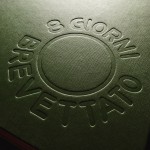 Find information about the content of our new book “The References” 1950’s-1960’s by using the “browse by tag” function. The tag 1392 is connected with all stories published about the second volume: watches, history, instruments and straps of the 1950’s-1960’s.
Find information about the content of our new book “The References” 1950’s-1960’s by using the “browse by tag” function. The tag 1392 is connected with all stories published about the second volume: watches, history, instruments and straps of the 1950’s-1960’s.
The second volume (page 697-1392) of the two-book-set “The References” is bearing the embossed “8 Giorni Brevettato” on the green canvas hardback jacket.
Our new “The References” books are in stock and ready for shipping – just visit our bookstore and enjoy reading soon! [Ralf Ehlers & Volker Wiegmann]
Click ‘696’ to find info on “The References” 1930’s-1940’s at a glance
by Volker on Aug.25, 2016, under Allgemein
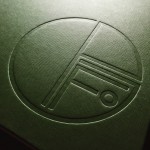 Find information about the content of our new book “The References” 1930’s-1940’s by using the “browse by tag” function. The tag 696 is connected with all stories published about the first volume: watches, history, instruments and straps of the 1930’s-1940’s.
Find information about the content of our new book “The References” 1930’s-1940’s by using the “browse by tag” function. The tag 696 is connected with all stories published about the first volume: watches, history, instruments and straps of the 1930’s-1940’s.
The first volume (page 1-696) of the two-book-set “The References” is bearing the embossed GPF logo on the green canvas hardback jacket.
Our new “The References” books are in stock and ready for shipping – just visit our bookstore and enjoy reading soon! [Ralf Ehlers & Volker Wiegmann]
Summer read – “left handed”
by Ralf on Aug.12, 2016, under Allgemein
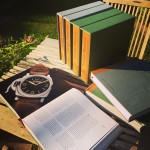 How about taking a seat in your frontyard, backyard or in a quiet corner of your garden? If your coffee table has a free corner for one of our four books, it could be a cozy time for a summer read:
How about taking a seat in your frontyard, backyard or in a quiet corner of your garden? If your coffee table has a free corner for one of our four books, it could be a cozy time for a summer read:
“History1” – four chapters, 420 pages
“History2” – five chapters, 480 pages
“The References” 1930’s-1940’s – five chapters, 696 pages
“The References” 1950’s-1960’s – seven chapters, 696 pages
The coffee table shot shows the book “The References” 1950’s-1960’s, with the famous “Destro” Ref. 6152/1 with “Marina Militare” dial (page 1054-1055) and Rolex 618 / Type 3 mod. movement. The 696 pages of this book feature watches from Guido Panerai & Figlio made in the 1950’s and 1960’s: Reference 6152, 6154, 6152/1, GPF 2/56 and modified References. Furthermore this book holds a chapter about compasses and depth gauges, as well as straps and buckles of this era.
All books are in stock and can be shipped soon – just visit our bookstore. Use the browse by tags function to read information about the content in each of the four books. Read how to place your order here.
Take a seat and enjoy reading!
[Ralf Ehlers & Volker Wiegmann]
“Two smurfs riding a carrot?”
by Volker on Aug.08, 2016, under Allgemein
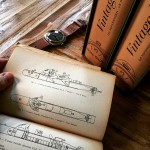 …no, thats not the way we would describe the illustration of a SLC (which still represents a piece of the heritage on some of the latest Panerai watches e.g. PAM00425 or PAM00577, ). Even during its development in the “early days” before the Second World War, it was nicknamed “maiale” (pig) from those who were testing it at Porto Santo Stefano, La Spezia and Bocca di Serchio from October 1935 to August 1936.
…no, thats not the way we would describe the illustration of a SLC (which still represents a piece of the heritage on some of the latest Panerai watches e.g. PAM00425 or PAM00577, ). Even during its development in the “early days” before the Second World War, it was nicknamed “maiale” (pig) from those who were testing it at Porto Santo Stefano, La Spezia and Bocca di Serchio from October 1935 to August 1936.
Looking back into the history of the legendary “Human Torpedo” (as it was often named), one of the inventors of the SLC (Siluro a lenta Corsa / slow running torpedo), Elios Toschi, once described the two-man torpedo as “a mini, electrically powered submersible with a completely new design, whose crew (pilot and copilot) ride the torpedo in a sitting position and will thus be able to target enemy ports at night in cover of darkness using luminescent instruments to navigate. On their way to their targets, they are in a position when underwater to be able to cut through net barricades, remove obstacles and operate with great endurance at depths of up to 30 metres thanks to their breathing equipment…”
Read more about “The birth of a legend – the first Panerai watches (1935-1939)” in chapter I, followed by the timeline of the missions of the Mezzi d’Assalto during the Second World War in chapter II.I – more information on the historic content in our “The References” book set with a total of 1392 pages can be found here and here. Read about the featured watches from Guido Panerai & Figlio in the first and second volume here.
A face behind a name…
by Volker on Jul.21, 2016, under Allgemein
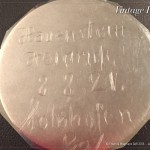 Since we added a Ref. 3646 / Type E “California Dial” into our database in March 2016, the personalized caseback of this watch got our attention, too.
Since we added a Ref. 3646 / Type E “California Dial” into our database in March 2016, the personalized caseback of this watch got our attention, too.
After the watch was auctioned earlier this year in May at Phillips (The Geneva Watch Auction THREE, lot 122, read the note in our watch point here), we continued research on the known personal dates, scratched with a sharp tool onto the caseback of the watch: Name, date of birth and home town of Heinrich Hauenstein.
[Photo with kindly permission / courtesy of www.phillips.com]
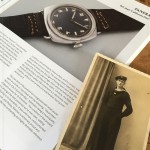 Having already a few watches with personalized casebacks recorded in our database, we wanted to find proof about the personalized dates in general and if further information about the history of the first owner of this watch could be found more than 70 years after its use.
Having already a few watches with personalized casebacks recorded in our database, we wanted to find proof about the personalized dates in general and if further information about the history of the first owner of this watch could be found more than 70 years after its use.
Since we exchanged information about Heinrich Hauenstein with his family, we know that he has passed away in 1976 at the age of 55. He was married but had no children. In 1951 he was a founding member of a shooting club in his hometown Solnhofen (Bavaria/Germany).
The family has recently shared a historical photo of Heinrich Hauenstein with us, dated October 1942 on the backside, showing him as a sailor of the German Kriegsmarine / Navy. To put a face behind the name on the caseback, we are pleased to publish here the photo from 1942 aside the auction catalogue from Phillips.
[Historical portrait photo with kindly permission / courtesy of Heinrich Hauenstein’s family]

